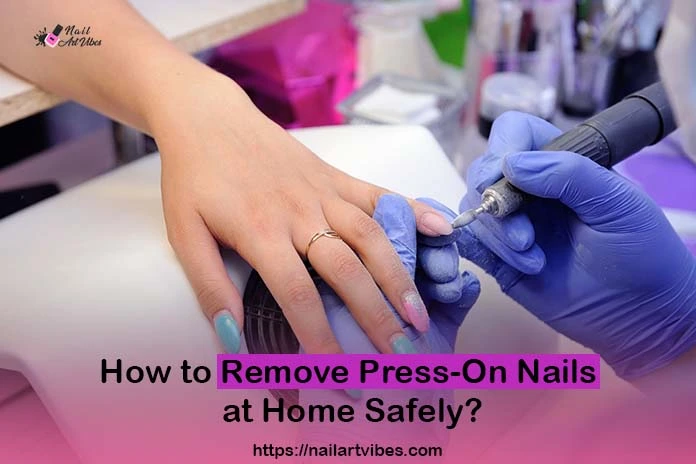Beginner’s Hassle Free Guide To Remove Acrylic Nails

Getting a fresh set of acrylics is something that gives you vibes, but if it’s time to get them off you might be looking for some DIY ways.
So, here we are with our findings on how to remove acrylic nails at home as a beginner.
In this blog guide, we’ll explore the simple steps and common questions surrounding acrylic nail removal.
Why Choose DIY Removal?
Everything has its lifespan so if the lifespan has already passed it’s time to get rid of it, similar is the case with acrylic nails. To get rid of them one may opt for a saloon removal or DIY procedure.
Saloon appointments work well if you can manage the time for an appointment in a saloon and you can afford it. But, if someone has to get acrylic nails off cannot afford money or manage time.
With a bit of accurate technique, she can succeed in doing it at home. You can do it in the comfort of your space, with your time comfort.
How To Remove Acrylic Nails At Home By Yourself
Method #1 Soaking in Acetone
If you have to get rid of your manicure set, acetone is something that performs magic. Soaking Soaking the nails in acetone helps dissolve the acrylic, making it easier to remove.
The recipe starts with gathering supplies;
Supplies
- Bowl of acetone
- cotton balls or pads.
- Cuticle Pusher
Procedure:
- Prepare Acetone Solution: You need enough acetone in a bowl that can allow soak your fingers in it easily.
- Soak Nails: Now, it’s time to soak fingertips & nail extensions into the bowl of acetone.
- Wait Patiently: Soaking does not instantly allow removal but you have to allow the nails to soak for approximately 15-20 minutes to allow the acetone to penetrate and soften the acrylic.
- Remove Acrylic: Now, as the acrylic is already softened you have to take a cuticle pusher to remove it. You don’t have to start from the tip instead start from the cuticle side.
- Repeat if Necessary: If you have the thicker acrylic coat, you may have to repeat the procedure to get it removed overall.
Method #2 Filing Down the Acrylic
Now, if you don’t want to wait to soak in acetone for your DIY procedure. A nail filer will do the job more quickly than method# 1. In this method, you gently file down the surface of the acrylic before soaking.
Filing helps speed up the removal process as it thins out the acrylic layer. A coarse nail file is necessary for buffing off the top layer. Be gentle as you go with the procedure so that you go smoothly without worsening the situation.
Supplies:
Procedure:
- Select a Coarse Nail File: A coarse nail file is a basic to effectively buff away the acrylic top layer.
- Gently Buff the Surface: File down the upper acrylic layer surface gently so you can smoothly thin out it.
- Avoid Over-Filing: You don’t have to work too aggressively, as the procedure can go wrong and can damage your natural nails.
- Prepare for Soaking: When you know is the most that you could file off now is the time to soak your nails in acetone.
Method #3 Use of Nail Wraps
To ensure getting every acrylic particle off experts believe that nail wraps or foil wraps soaked in acetone target specific areas more effectively.
After you are done with filing the acrylic, wrap each nail in a piece of cotton soaked in acetone, then cover it with a small square of aluminum foil.
Time to gather Supplies;
Supplies:
- Bowl of acetone.
- Foil wraps.
- Cotton Balls.
- Manicure stick.
Procedure:
- Prepare Acetone and Nail Wraps: Take small cotton pieces and soak them nicely in the acetone. Now, take each piece one by one and place it on the nails you want to remove acrylic from.
- Secure with Foil or Nail Wraps: Now, wrap the fingernails which are already wrapped by soaked cotton pieces into aluminum foil pieces tightly. Try to make it nicely wrapped so the job is nicely done.
- Allow for Soaking: Let the acetone-soaked cotton and wraps sit on the nails for about 15-20 minutes to allow the acrylic to soften.
- Check Progress: When the waiting period is over unwrap and see if the acrylics have softened or not.
- Gently Remove Acrylic: With a manicure stick or cuticle pusher, you have to gently scrape down the softened acrylics.
- Repeat if Needed: The thickness of the acrylic decides if the procedure is done or if you need to repeat it, keep going until it is
What if You Don’t Want to Use Acetone?
Everyone has preferences, and if you don’t prefer using acetone no need to worry. We’ve also got acetone acetone-free method to treat those with sensitivities after all acetone is not a must.
Method #4 Acetone Free Nail Polish Remover
We’re not using harsh or abrasive ingredients like acetone in this part. Instead, we have gentler ingredients to break down the acrylic, nicely. Acetone has a quick response but these removers typically take longer. But as we respect your preference this is a better option for those with sensitive skin or respiratory issues.
Supplies
- Acetone-free nail polish remover.
- Cuticle Pusher
- Cotton ball
Procedure
- Select a Non-Acetone Remover: Opt for a polish remover look for a non-acetone version or a specialized acrylic nail remover product.
- Apply to Nails: Just as we did in the prior method, the small cotton piece soaked in the chosen solution should be wrapped around your fingers to saturate nicely .com.
- Let It Sit: Wait for a duration, of course, a longer one to make it work.
- Gently Remove Acrylic: With a manicure stick or a cuticle pusher, push away the softened acrylic.
- Repeat as Needed: Repeat the process until the acrylic is finally gone
Acrylic Removal is done, What’s Next?
Congratulations on the successful DIY removal of your acrylic nails. Now, it’s time for basic nail care to make your natural nails breathe for a while.
Procedure:
- Moisturize: To moisturize is important, with any specified or general moisturizer hydrate your cuticles and nails well.
- Trim and Shape: With the help of a gentle file shape your nails after trimming to the desired length and shape.
- Strength and Protection: Here, you need nail strengthener cream as it will secure the nail and cuticle with a protective layer.
- Give Them a Break: Giving a break to your natural nails is important because this is what they deserve.
How Much Gap Between Acrylic Sets?
After getting your acrylics removed you need to give your nails a break, Natural nails have to breathe, because they have to regenerate and regrow, just like any other organ or part of the body you cannot just ignore this. Every nail geek has to take a one to two-week break until they get a new set.
FAQ’s
Q: How can I remove acrylic nails at home safely?
A: File off the upper layer of your acrylics using a nail file gently and then soak off in acetone to rinse off properly.
Q: Can I remove acrylic nails without acetone?
A: Yes! There are acetone-free removal methods as well, like using acetone-free polish remover or rubbing alcohol.
Q: How long does it take to remove acrylic nails with acetone?
A: By wrapping acetone-soaked cotton balls around your nails acetone works at a speed of only ten to fifteen minutes and the procedure is done.
Q: What are alternatives to acetone for acrylic nail removal?
A: Opt for rubbing alcohol or non-acetone polish removers.
Q: Should I go to a salon for acrylic nail removal?
A: If you haven’t tried such a method earlier and are concerned about it, of course, you should go to a salon because you need professional Assistance.
Conclusion
Acrylics are so on trend these days, so is the need to learn for diy ways to remove a set that you already have. Acetone is the quicker solution to all situations, still if you are acetone-sensitive I have other options as well.
Opt for what’s more suitable for you and keep on nailing!






